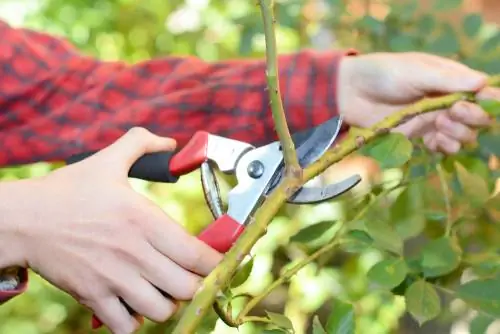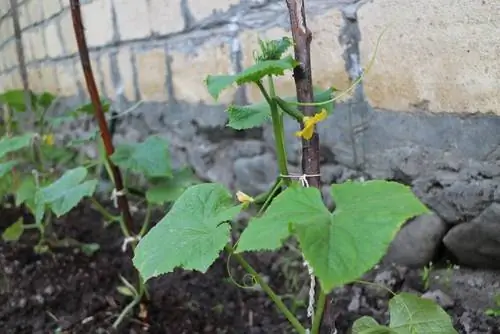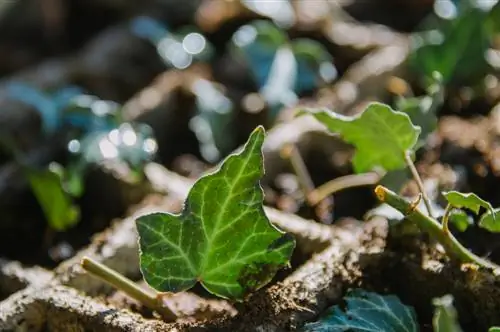- Author admin [email protected].
- Public 2023-12-24 06:09.
- Last modified 2025-06-01 06:02.
Climbing roses challenge the gardener when it comes to pruning care with thorny, epically long tendrils. Anyone who ignores the differences between ramblers that bloom once and climbers that bloom more often will be denied the fairytale splendor of flowers. This tutorial gives beginners in rose care all the trump cards for the perfect cut.
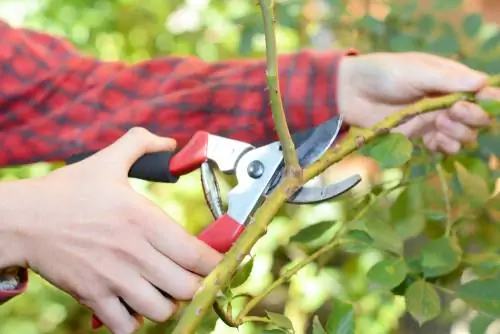
When should I cut the climbing roses?
Cut the climbing roses on the day they are planted and the following spring. The cut depends on the type of rose. How to prune forsythia in March or April. Rambler roses get a rejuvenation cut every 5-7 years. Cut roses that bloom once a year and those that bloom more often in spring and summer.
Single-flowering and repeated-flowering varieties
Cutting climbing roses becomes a gardening success story if you know the specific flowering characteristics of the variety. Varieties that bloom once - called ramblers - undergo different pruning than varieties that bloom more often - so-called climbers. We summarize important differences below:
Single-blooming climbing roses (Rambler)
- Flowering period: May to July
- Flower system: on previous year's side shoots
- Strong growth with long,flexible tendrils
- Growth height: 350 to 900 cm
- Use: Greening of rose arches, arbors, old trees, mighty facades
Frequently blooming climbing roses (Climber)
- Flowering period: May to July, re-blooming from August to October/November
- Flower system: on this year's, annual and perennial tendrils
- Strikingly larger flowers than Rambler
- sparse growth with woody,stiff-leggedshoots
- Growth height: 200 to 350 cm
- Use: Greening of small columns, defined areas of house walls, obelisks, trellises
An important difference relevant to pruning is thatClimber rosesform abasic framework Each framework shoot carries comparatively short side shoots as valuable flower wood. The first flowers appear on annual and perennial side shoots from May to July. At the same time, this year's tendrils sprout from the scaffolding shoots to enchant with long-lasting subsequent blooms.
Rambler rosesdo without a framework Here the growth is determined by long tendrils from the base with an annual increase of up to 600 centimeters, which bloom the next year from June onwards. Without the occasional pruning, climbing roses turn into an impenetrable tangle of old and young, meter-long shoots. The Brothers Grimm certainly had Rambler roses in mind when they described Sleeping Beauty's Castle.
Cutting types and dates
The rule of thumb for pruning climbing roses is: cut once-flowering varieties once a year - cut more frequently-flowering varieties twice a year. The following table provides an overview of the most important types of cuts with information on the best time for each:
| Cutting types/dates | Single flowering (Rambler) | Frequently flowering (Climber) |
|---|---|---|
| Plant cutting | on planting day and the following spring | on planting day and the following spring |
| Conservation cut (main cut) | from the 5th year in spring | in spring (March/April) |
| care cut | not applicable | in summer (end of June/beginning of July) |
| Rejuvenation cut | every 7 years in February | in stages in February |
Rosen gardeners are increasingly noting autumn as an additional pruning date. A separate tutorial explains under which conditions it makes sense to prune roses again at the end of the season.
Planting pruning and first formation
The best time to plant climbing roses is in autumn. This applies primarily to bare-root roses, which root quickly in sun-warmed soil. Roses grown in containers can be in the ground all year round, but the elegant flowers also benefit from an autumn planting season. A planting cut is advantageous for both cultivation variants because it makes it attractive for young climbing roses to start in the new location. How to do it professionally:
Naked-root climbing rose
- On the day of planting: cut roots back to 20 to 25 cm long, remove damaged shoots
- In spring: shorten shoots to 3 to 5 eyes
Container Rose
- On the day of planting: rootsdo not prune, remove damaged branches
- In spring: cut shoots back to 3 to 5 eyes
Climbing roses grown in pots generally do not receive any root pruning. An exception applies to root strands with twisted growth that protrude over the edge of the pot or grow out of the opening in the ground. Roots with twisted growth do not give a climbing rose any stability and are cut back to the point where they emerge from the ball of soil.
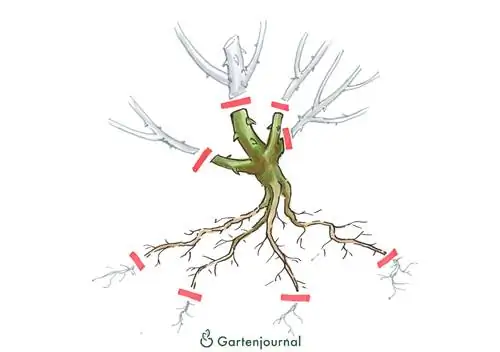
On bare-root climbing roses, cut the root strands back to 20 to 25 cm before planting. Container roses are left uncut on planting day. Next spring, cut all shoots to 3 to 5 buds.
Cut Rambler once a year
Reward for an annual maintenance cut of Rambler roses are an opulent bloom in the summer. Single-blooming climbing roses are created directly from wild roses. As a result, its long tendrils sprout directly from the base, bear dense clusters of flowers in early summer and delight with decorative rose hips in autumn. As long as you can reach the vigorous climbing roses without risky climbing, you are directing the growth in the desired direction. How to cut correctly:
- Rambler cut once a year from the 5th year onwards in February
- Tighten and pull out bald, dead tendrils at the base
- Excessively long shoots hanging at head height lead to a side shoot positioned further down
- As the summer progresses, tie this year's rods diagonally to horizontally
If possible, do not cut back previous year's long shoots, as these have the most flower buds. If you find yourself forced to thin out an old tendril, divide the shoot into several pieces. This makes it easier to pull the old wood out of the climbing rose. If in doubt, gently shaking can loosen the knots so that no young tendrils are affected when pulled out.
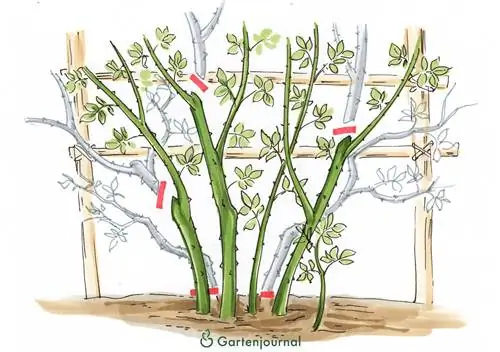
Pruning every year keeps vigorous rambler roses tidy. Thin out aging ground shoots. Excessively long tendrils direct you to a deeper young shoot. Tie this year's vines horizontally.
Tip
Single-blooming ramblers demonstrate their vigor by sometimes sprouting very long, very thin shoots shortly before flowering. Cut these “fishing rods” back to two to three eyes.
Rejuvenate Rambler roses every 7 years
Trail roses that have been left uncut for a long time turn into an impenetrable network of vital and old and dead tendrils. Considerable weight makes Rambler roses a safety hazard over the years. It is advisable to note a rejuvenation cut on the schedule for climbing roses that bloom onceevery 5 to 7 years. The best time is in late winter, in accordance with the regulations in the Federal Nature Conservation Act. How to do it right:
- Put on safety glasses, thorn-proof clothing and gloves
- Cut out young shoots close to the ground in advance, remove them from the trellis and place them on the ground
- Cut dead, bare tendrils with scissors
- Detach sections of the climbing aid and pull them out
The flexible nature of rambler vines benefits you when rejuvenating. Young, vital wood in particular can be easily placed on the ground and then reattached to the climbing aid or the host tree.
Frequently blooming climbing roses - maintenance pruning instructions
When the forsythias bloom in spring, the window of opportunity for pruning roses opens. Climbing roses that bloom more often form a stable framework and grow weaker than ramblers. These properties simplify pruning care. The primary goal is to promote numerous side branches. Perennial side shoots bloom from the end of May and pass the floral baton on in August to this year's side branches, which bloom until the first frost. With this cut you will do it right:
- Remove as many shoots as possible from the trellis and place them sideways on the ground
- Cut back all side shoots on scaffold shoots to 3 to 5 eyes
- Make the incision at a distance of 5 to 10 mm from one eye
- Care: do not cut promising long shoots from the previous year
- From the 5th year: thin out one or two older scaffold shoots as a continuous rejuvenation measure
The image below illustrates what a climbing rose should look like before and after spring pruning. You have done everything right if the scaffold shoots are reminiscent of a “chicken ladder”. The tiered structure supports the growth of lateral flowering wood and simplifies formation on the trellis.

The sketch illustrates how you should cut the second and third order shoots back to two or three eyes so that the shoots can be formed airily and decoratively on the trellis after spring pruning.
Background
Tie rose tendrils horizontally
Vertical rose vines become bare at the bottom. Budding and flowering only take place at the upper end because the growth law of peak promotion governs here. As soon as you tie a tendril horizontally, growth calms down. Now your climbing rose has the time and leisure to produce numerous leaf and flower buds, spread over the entire length of the shoot. Tieyoung rose shootsto the bottom of the trellishorizontal. Older shootsIn the upper area you direct aslanted position This optimizes the flower splendor and ensures an even formation on the trellis.
Frequently flowering climbers - instructions for care cutting
After the first round of blossoms, another rose festival will get going when you clean out your climbers. Summer pruning of climbing roses is extremely easy and still achieves a maximum of flowers until the first frost. This is how you properly prune climbing roses that bloom more often at the end of June/beginning of July:
- Examine the climbing rose carefully for breeding birds so that if necessary, you cannot cut it or cut it later
- Sharpen and clean the rose scissors, put on thorn-proof gloves with cuffs and safety glasses
- Grip the dead vine with one hand and bend it slightly
- Place the scissors at a short distance above the first complete leaflet
Tie this year's growthdiagonally to horizontally to the trellis. As spreading climbers, climbing roses do not have adhesive organs or the ability to wind themselves around a strut. Please use soft, stretchy binding material that does not cut into the bark and can be easily opened for cutting purposes.
Excursus
Test cut provides security
Some of the most beautiful climbers react angrily to the thinning out of old ground shoots. If you are subjecting a climbing rose that blooms frequently to continuous rejuvenation for the first time, you should carry out a trial cut. For the test run, cut off a maximum of a third of the aged branches at ground level. If the climber sprouts again willingly, remove the remaining old branches next spring. If not, your climbing rose is one of the sensitive varieties. Plant a ground cover rose or small shrub rose to conceal the balding foot. In spring, tulips cover up the aesthetic deficiency with their picturesque flowers.
Rejuvenate Climber in stages
Old climbing roses age at the tips of the shoots and become bare from the base. Instead of discarding a formerly magnificent climber rose, it is worth experimenting withstagewise rejuvenation. In gardening practice, it has proven to be a good idea to spread the measure over 3 years. This is how the plan works:
- The best time for each stage is in February when the weather is frost-free and dry
- Saw off a third of the dead or bare scaffold shoots at ground level
- On the remaining scaffold shoots, massively branched tips lead to a side shoot further down
- Then cut back the young side shoot to 2 to 3 buds
Subject the already rejuvenated areas to a maintenance cut in the spring and a care cut in the summer. Please pay particular attention to adequate water and nutrient supply during rejuvenation. You can stimulate growth with an organic complete fertilizer such as Oscorna Animalin. Apply the fertilizer from April and water generously.
Background
Derivation - fundamental cutting technique
In the pruning care of trees, bushes and roses, derivation pruning plays a key role. The secret of the fundamental pruning technique is that worn-out branches are strategically and cleverly redirected to a promising side shoot. On an aged scaffold shoot of your climbing rose, look for a conveniently positioned side branch at the bottom. At the fork between old and young, cut off the branching broom.
Frequently asked questions
My frequent-blooming climbing roses are 2 years old and bloomed magnificently this year. Should I cut the climbers now in the fall or in the spring?
You can prune climbing roses that bloom more frequently throughout the season. The best time for main pruning is in spring when the forsythia is blooming. Regularly cleaning out withered flowers will attract fresh rose petals. In locations exposed to wind, it makes sense to prune in autumn so that you can get the roses close to the climbing aid. This reduces the risk of wind breakage to a minimum.
How many individual leaves do the pinnules of a climbing rose consist of? Our Climber sprouts meter-long, thumb-thick shoots without side branches with five to seven leaflets. Are these wild shoots?
Five to seven-part leaflets are a criterion for shoots of a noble rose. Under the influence of wet and cold weather or when there is an excess of nitrogen, climbing roses tend to grow very long, so-called horny shoots. Of course, even the normal annual shoots on young climber roses can become extremely long. Annual pruning in spring promotes strong branching in the long term. You can identify wild shoots by their lighter foliage and nine to fifteen leaflets.
We planted the frequent-blooming climbing rose 'Santana' in May. It's blooming for the first time in July. Does the rose need climbing aid? Will pruning actually be necessary next year?
Climbing roses cannot survive without a stable trellis. The tendrils do not have their own adhesive organs, but must be tied up and guided accordingly. As they grow, climbing roses spread their thorny side shoots apart to entangle themselves with a trellis or tree bark. In principle, you can let a climbing rose grow uncut. Annual pruning in early spring is beneficial for a decorative arrangement on the trellis and an opulent abundance of flowers. If you cut your climbing rose into shape in stages and tie the tendrils diagonally to horizontally, it will quickly green up the facade and form flowers over the entire area.
Are climbing roses suitable for a container? How big should the pot be at least?
If a climbing aid is available, you can keep climbers and ramblers in the bucket. Another important requirement is a sufficient supply of water and rose fertilizer. A bucket should be at least 70 cm deep so that the deep roots can develop well. As growth progresses, repot a climbing rose into a larger pot as soon as the existing container is completely rooted.
Our rambler rose grows in an apple tree, which dies due to fungal infection. When is the best time to transplant the climbing rose? What is the best way to proceed?
If your climbing rose has lost its foliage, you should transplant. Dig the root ball as deep and wide as possible to reduce loss of root mass. Cut the rambler rose back to 50 centimeters above the ground and plant it promptly at its new destination. Please choose a location where there have been no rose plants in the previous 3 to 4 years to avoid the problem of soil fatigue.
The heavy weight of our climbing rose damaged the rose arch. When and how far can I shorten the rose for repair work?
It is easily possible to cut back a climbing rose by up to two thirds. The disadvantage of pruning is the loss of flowers over several years. There are two dates to choose from. A climbing rose copes best with the measure in October or February. If you do the cutting before winter, cover the plant with a rose cap made of fleece. To ensure that the lost plant mass is quickly made up, we recommend administering a complete organic fertilizer, such as Oscorna Animalin, from April onwards.
The 3 most common cutting mistakes
If the gardener cuts his once-blooming climbing rose like a repeat-blooming climber rose, the worst case scenario is that all hopes of the next blooming period are gone. If climbing roses are bare-footed or suffer from diseases, they are also victims of incorrect pruning care. The following table summarizes the three most common cutting errors with helpful tips for prevention:
| Cutting errors | malicious image | Prevention |
|---|---|---|
| Rambler cut like Climber | Failure of the next flowering period | Thing out single-flowering varieties once a year |
| long tendrils just shortened | progressive baldness from the base | Cut climbing roses in stages (keyword chicken ladder) |
| aimlessly cut | Growth depression, dried buds, rampant diseases | Cut 5-10 mm above one eye |

Tip
If climbing roses with poor growth cause concern to your gardener, the problem is often due to unsuitable foot soldiers. Although roses and lavender complement each other wonderfully visually, their requirements for water and nutrient supply differ widely. Phlox, lady's mantle or gypsophila, which are also welcome companions for clematis, are more suitable as underplanting.

